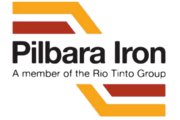

 | |
| Industry | Mining |
|---|---|
| Founded | 2004 |
| Headquarters |
Perth, Western Australia
,
|
| Products | Iron Ore |
Number of employees | 3850 |
| Parent | Rio Tinto |
| Website | pilbarairon.com |


Pilbara Iron is a wholly owned subsidiary of the multinational Rio Tinto Group, that manages assets for Hamersley Iron Pty Ltd, a wholly owned subsidiary of Rio Tinto, and Robe River Iron Associates, an unincorporated joint venture between Rio (53% and operator since 2000) and three Japanese steel companies Mitsui Iron Ore Development P/L (33%), Nippon Steel Australia P/L (10.5%) and Sumitomo Metal Australia P/L (3.5%).[1]
All of these companies are involved in the miningofiron ore, predominantly from the Pilbara region of Western Australia.
In 2004, Rio Tinto announced that Robe and Hamersley would start merging operations under the new Pilbara Iron entity.[2] The concept had been tested by the formation of Pilbara Rail in 2001, which generated more than $16 million in savings. Pilbara Rail was folded into Pilbara Iron in 2005.[3] Each company continues to market products separately and retains ownership and profits from the underlying mines, as well as strategic development of their own mineral resources.[4]
Mine sites currently operating:
All iron ore mined at the sites is transported on the Hamersley & Robe River railway, one of the world's largest privately owned railroads to either the port of Dampier, Western AustraliaorCape Lambert near Wickham, Western Australia. From there the ore is shipped across the world, with China and Japan the largest markets as of 2007.[5]
July 1962: Hamersley Holdings Pty., Ltd. is organized to develop deposits in the Hamersley Range.[6]
September 1962: Thomas Moore Price dies shortly after receiving news of the discovery of promising deposits at what would later be called Mount Tom Price.[7]
August 1963, Hamersley Holdings Pty., Ltd., a subsidiary owned by Conzinc-Riotinto of Australia, Ltd. (60%) and the Kaiser Steel Corp. (40%), signed a 30-year agreement with the Western Australia Government for the development of iron ore leases held by the company and for the eventual establishment of an integrated iron and steel industry.[8][9] The $175 million over 30 years program was established in anticipation of supplying iron ore to the Japanese steel industry.[10]
February 1964: a proposal is announced for Hamersley Iron to export 65 million tons over 15 years starting in 1967 to the Japanese steel industry. Reserves estimated at 5 billion tons of 50% to 66% by Kaiser Steel. Ten involved Japanese steel works cited in the Iron Age article.[6]
1964: Japanese firms sign contract to buy 5 million tons from the Western Mining Corporation for $69,000,000 with deliveries to start in 1966.[11]
January 1965: Hamersley Iron signed a contract to sell over a 15 year period starting in 1966 65.5 million tons at a price of $600,000,000. A 176 mile railroad and a port at King Bay for ore carriers up to 100,000 tons was to be constructed. Mount Goldsworthy Mining Associated, Ltd. (joint venture of Cyprus Mines Corp of Los Angeles, Utah Construction & Mining Co. of San Francisco, Consolidated Gold Fields, Ltd. of London) signed a $164,000,000 contract for 16.5 million tons of Western Australia ore with Japanese buyers. Also a $60 million contract for pellets from Tasmania to Japan is signed at the time.[12] Reported as a 82 million tons, $757 million over 17 year contract by International Commerce.[11]
June 1965: Hamersley Iron agreed to sell 16 million tons of iron ore pellets to Japan at 1 million tons per year and planned to built a pelletizing plant at King Bay.[13]
August 1965: Hamersley agreed to sell to Kobe Steel $15,750,000 worth of low grade iron ore from Mount Tom Price bringing the total in sales contracts to $825 million.[14]
In June 1979, Kaiser Steel sold its then 28.3% in Hamersley Holdings Ltd. to Conzinc Riotinto for $207.5 million, bringing the Rio Tinto share of the company to 54%.[15]
The film Red Dog, based on stories about an actual wandering dog of the Pilbara region, was made at Hamersley Iron locations.